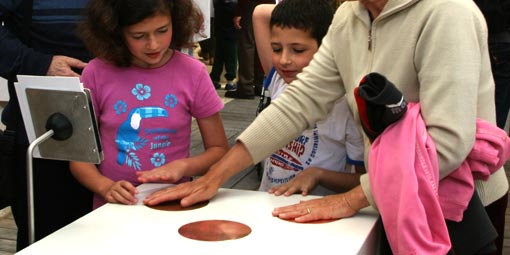


 |
||
 |
||
|
The exhibit demonstrates that our senses are most sensitive to differences or changes. We become adapted to constant stimuli and we are therefore less sensitive to their existence. When we press our hands on cold and warm surfaces, after a while we become adapted to the temperature and hardly feel the coldness or warmth. But if we then place our hands on a surface at room temperature it feels warm to the hand that was on the cold surface and cold to the hand that was on the warm surface. As with vision, and for essentially the same reasons, our other senses show increased sensitivity to sudden changes at the expense of slow changes or judgment of ABSOLUTE intensity (lightness, loudness, strength of pressure, strength of smell or taste) or quality (colour, pitch, hot and cold, smell or taste). We quickly ADAPT ourselves to a steady stimulus, meaning reduce our sensitivity to that stimulus if it is strong or increase it if it is weak. This adaptation is a form of negative feedback, and may occur at several levels of the nervous system. For instance, in vision, the first level is the control of the opening of the pupil; the second (and most important) is a change in the biochemical amplification system of the photoreceptors of the retina; and the third is a less well known contribution of cortical brain processes. As in vision, the adaptation may be 'local', meaning that it does not transfer from one visual area to another or from one eye to the other; or, in this exhibit, from one hand to the other. The adaptation, or change in sensitivity, apparently occurs in the receptors of the skin sensitive to temperature, and it is so effective that after a few moments we can hardly tell that one hand is feeling cold and the other warm. However, when the adapted hands are moved to the central disc, the hand that was adapted to the cold immediately feels the increase in temperature, and the hand that was adapted to the heat immediately feels the decrease in temperature. The feeling gradually fades as the hands reach a new, and common, adaptation state.
|
||

 Hot and Cold
Hot and Cold